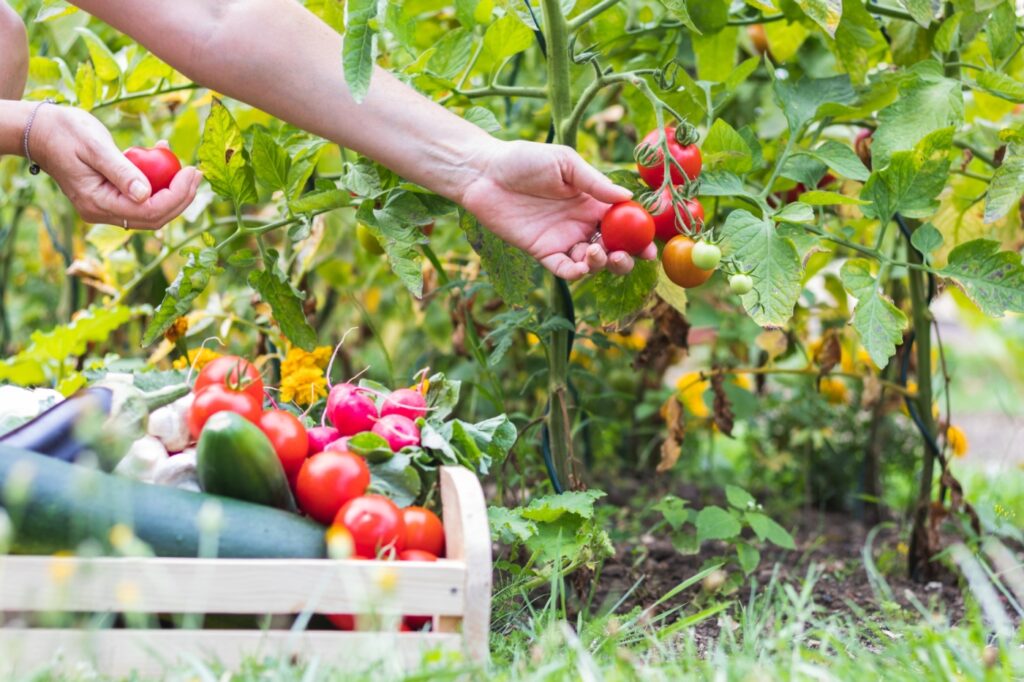
1. Corn and tomatoes are self-pollinating. In corn, pollen from tassels falls onto the silks below. In tomatoes, pollen from a male stamen is transferred to a female stigma on the same flower. This process for both plants is generally facilitated by the wind so you may see less of a crop in an area where breezes don’t blow. To maximize pollination, it is therefore recommended to manually shake corn tassels so their polllen is shed onto the silks below. You shake tomato plants so that pollen is dislodged until it comes to rest on a sticky stigma. Tomato pollen is also released by the vibrations of bumble bees, so if you see them hovering around your tomato flowers, take heart. Growers of greenhouse-cultured tomatoes bring in bumble bees to maximize pollination and yield.
2. Propagate virtually any woody perennial, shrub, rose bush, or vine through a process known as layering. Dig a shallow trench and bend a low, flexible shoot, after scraping off around two inches of its bark, into the trench. The portion that is scraped should be at least six inches away from the end of the shoot. Bury the portion of shoot with the scraped bark in the trench, holding it in place with landscape staples used for holding drip tubing or soaker hose snug against the ground. A significant clump of roots will eventually form where the bark was scraped, at which time you can detach the shoot from the mother plant, taking care to dig up as much soil as possible around the roots before transplanting to a container or other part of the garden. Prior to burying the shoot, dusting the area where bark has been removed with root hormone may accelerate the rooting process.
3. Where birds poaching on your fruit is a problem, forego bird netting and utilize tulle fabric instead. The problem with plastic bird netting is that shoots can grow through it and then it is a chore to untangle them from the netting. Tulle fabric, on the other hand, allows shoots to grow freely without getting tangled up in it. You can cover blueberry bushes and small trees in their entirety with this fabric while the fruit-bearing branches of larger trees can also be covered. Tulle fabric will also protect vegetables from the depredations of rabbits. You can find tulle fabric, which is significantly less expensive than plastic bird netting, at papermart.com. When you get there, search “economy-colored polyester tulle in bolts.” Thanks to Greg Alder (gregalder.com) for this useful tip.
4. As ironic as it sounds, one of the most problematic aspects of growing vegetables is harvesting them in a timely manner so that the pleasure of eating them is not lost. Perhaps this is due to laziness or perhaps to pride: We are so pleased with what we’ve grown that we just want to look at our beautiful crops and resist removing them from stem or stalk or soil. However, if you delay harvest once your vegetables are ready for picking, you will lose out on quality and sometimes lose them altogether. Delaying harvest may lead to rubbery pods on snow peas, sunburned bell peppers, split tomatoes, earworm-infested corn, woody or cracked carrots, pithy radishes, over-sized and flavorless zucchini, hardened asparagus spears, and lettuce that becomes bitter when it bolts (sends up flower stalks).
5. Climbing roses that only bloom over a single season such as Lady Banks and Cecile Brunner should be pruned when they stop flowering around this time, as opposed to late winter pruning recommended for roses in general. Although they put out massive growth each year, pruning of these climbers is less of a chore since both varieties are almost thorrnless. Lady Banks, with double white or yellow double flowers, and Cecile Brunner, with double pink blooms, are both mildly fragrant too.
Your questions, comments, and photos are always welcome and should be sent to joshua@perfectplants.com.
Related Articles
What you should know about indicator plants in your garden
Master Gardener: How to keep your lawn free of weeds
Gardening: How to plant a container like the pros do
Trellising tomatoes and harvesting herbs: 5 things to do in the garden
668 mushroom varieties explored in new book, ‘Mushrooms of North America’
